
A visit to my local farmer’s market reminded me of Rob’s trip to a garden fair in San Casciano in Val di Pesa some years ago. He happened to be in Italy shopping for terra cotta, and saw an announcement for the Giardini in Fiera. Literally translated “garden in flower”, he was intrigued. He took the morning and travelled south of Florence to the fair.
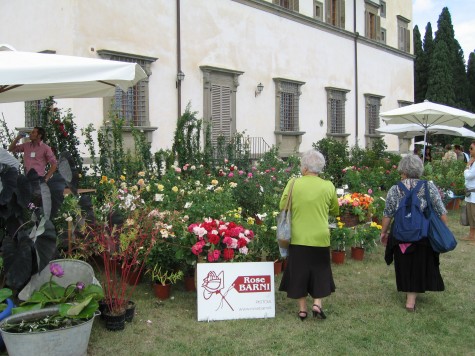
He was not disappointed. Much like our market, there was a little of everything to see, and buy. Roses, shrubs, waterlilies, grape vines, fruit trees, evergreen topiaries and the like. Not fancy – festive. Just people who grow plants exhibiting for people who garden and grow good fruit to eat.
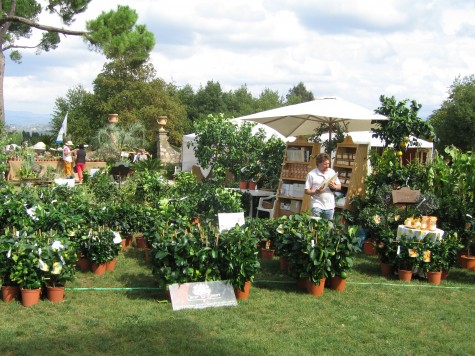 Fruit trees, fruiting shrubs and grape vines were represented in lots of varieties. We plan to offer fruiting trees, shrubs and grapevines at the store this coming spring, as Rob’s memory of this fair is a strong and good one. My favorite-the fruit cocktail trees, with 5 varieties of apples or pears, grafted onto a single rootstock. The idea of this appeals to my idea of gardening fun and festivity. I would have loved trees like this as a child, and I still do.
Fruit trees, fruiting shrubs and grape vines were represented in lots of varieties. We plan to offer fruiting trees, shrubs and grapevines at the store this coming spring, as Rob’s memory of this fair is a strong and good one. My favorite-the fruit cocktail trees, with 5 varieties of apples or pears, grafted onto a single rootstock. The idea of this appeals to my idea of gardening fun and festivity. I would have loved trees like this as a child, and I still do.
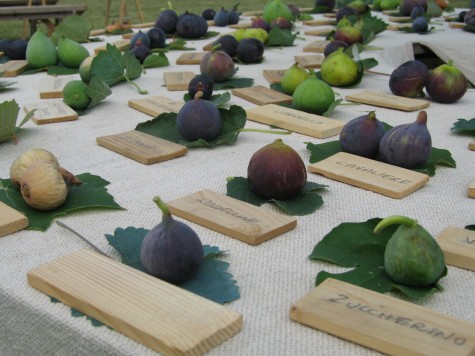 This display of different varieties of figs-more fun. How better to choose a fig tree than to have the fruit in front of you to hold, smell, and see? I do have a client of Italian descent growing fig trees; her love of gardening, growing food and cooking she inherited from her grandfather. One of his grapevines now grows in her garden. She is willing to bury her fig trees in compost for the winter-this tells you how much she wants them. How I envy the Italian climate such that they can grow figs, lemons and limes.
This display of different varieties of figs-more fun. How better to choose a fig tree than to have the fruit in front of you to hold, smell, and see? I do have a client of Italian descent growing fig trees; her love of gardening, growing food and cooking she inherited from her grandfather. One of his grapevines now grows in her garden. She is willing to bury her fig trees in compost for the winter-this tells you how much she wants them. How I envy the Italian climate such that they can grow figs, lemons and limes.
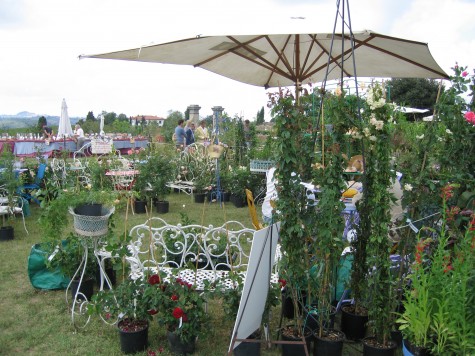 The little of this and some of that quality of this fair is engaging and charming. This is my favorite time of year for my own farmer’s market. The produce and fruit is as beautiful to look at, as it is to eat. The bunches of cut flowers, grass bouquet’s, the evidence of the summer harvest, speaks to much about why I garden. Making something grow is just plain satisfying.
The little of this and some of that quality of this fair is engaging and charming. This is my favorite time of year for my own farmer’s market. The produce and fruit is as beautiful to look at, as it is to eat. The bunches of cut flowers, grass bouquet’s, the evidence of the summer harvest, speaks to much about why I garden. Making something grow is just plain satisfying.
 The apples and pears have the spots, dings and scars that come with naturally grown fruit. Years ago I owned five acres that came with 20 fruit trees. I would pick the fruit warm from the sun and eat right then and there-around the spots if need be. This is a version of fine dining that I like.
The apples and pears have the spots, dings and scars that come with naturally grown fruit. Years ago I owned five acres that came with 20 fruit trees. I would pick the fruit warm from the sun and eat right then and there-around the spots if need be. This is a version of fine dining that I like.
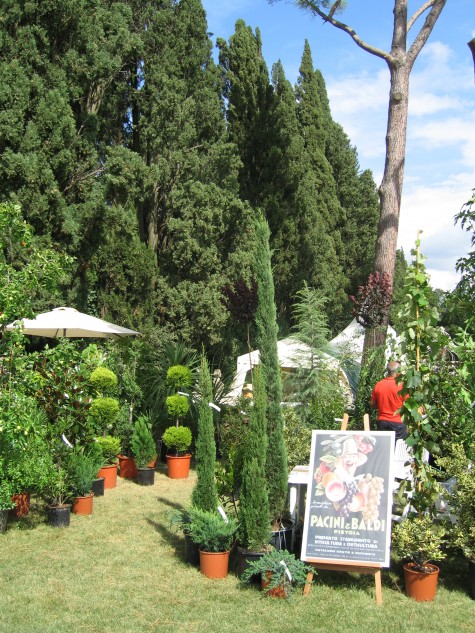
Would it not be great fun to load up a few potted Italian cypress from the fair for your garden? I want things that I cannot have as much as the next person. For years I nurtured to magnolia grandiflora trees in pots, and garaged them for the winter. Eventually I had to give them up; they grew too big to handle. My magnolias blooming outside in Michigan in June-what romance, while it lasted.
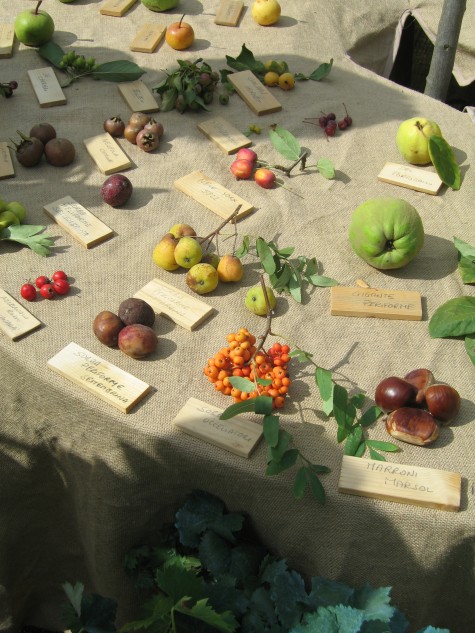 I am able to buy and eat food that cannot be grown where I live. I am glad I do not have to do without figs, lemons and mangoes. But Rob’s pictures make me wish I had been there.
I am able to buy and eat food that cannot be grown where I live. I am glad I do not have to do without figs, lemons and mangoes. But Rob’s pictures make me wish I had been there.
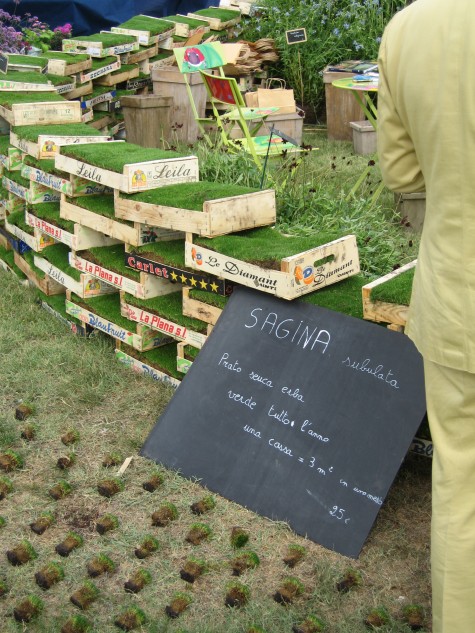 This is my favorite display-sagina subulata grown in fruit boxes. What a gorgeous look. This I could easily do. I might even like to just grow it in boxes. What would never occur to me to do-display the spacing layout on the ground. The sign says one box will get you three square meters of Sagina; if you don’t believe it, look here.
This is my favorite display-sagina subulata grown in fruit boxes. What a gorgeous look. This I could easily do. I might even like to just grow it in boxes. What would never occur to me to do-display the spacing layout on the ground. The sign says one box will get you three square meters of Sagina; if you don’t believe it, look here.

This basket of fruit looks delicious, yes.
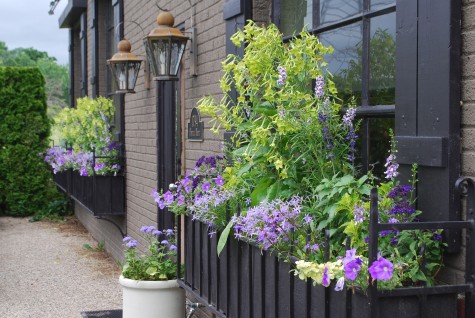
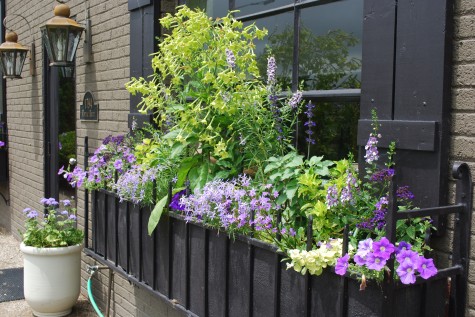 No matter what you fancy in your garden, nothing in it ever stands still. A garden actively grows, or actively sulks, or goes down. Some days I wish I could shift into neutral and coast, but I know better. I also know that as much as I would want to devote a chunk of time to nurturing all my plants, every day, that rarely happens. I have a demanding work life; moving that along every day takes priority. I hedge my bets some with plants that seem to handle the hit and miss nature of my care. Petunias thrive on this treatment; this is one plant that the more I fuss with them, the more they resent it. A trim once in a while is enough. Angelonia does not like cold weather, but it’s not a prima donna either. Once the hot weather comes, they come on strong.
No matter what you fancy in your garden, nothing in it ever stands still. A garden actively grows, or actively sulks, or goes down. Some days I wish I could shift into neutral and coast, but I know better. I also know that as much as I would want to devote a chunk of time to nurturing all my plants, every day, that rarely happens. I have a demanding work life; moving that along every day takes priority. I hedge my bets some with plants that seem to handle the hit and miss nature of my care. Petunias thrive on this treatment; this is one plant that the more I fuss with them, the more they resent it. A trim once in a while is enough. Angelonia does not like cold weather, but it’s not a prima donna either. Once the hot weather comes, they come on strong. 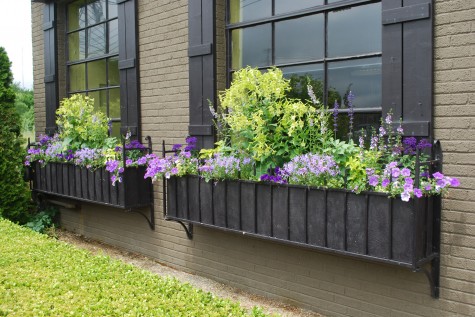 Blue salvia is puny early on; it is a late season annual. In a good year, they handle cooling fall temperatures with aplomb. I knew I would have these late. Planting the blue star-flowered laurentia was risky. Not only am I not so familiar with its habit, it has that look of an early season annual destined to peter out. This I cannot really explain, except to say some plants just look like they won’t do. The heliotrope was stuck in first gear; this plant likes hot weather. But for the moment, the lime nicotiana alata has my attention; the weather was instrumental in making it look perfectly happy. Every year, the weather is perfect for something; I thus follow the National Weather Service three month predictions with a lot of interest in late winter. Occasionally that helps.
Blue salvia is puny early on; it is a late season annual. In a good year, they handle cooling fall temperatures with aplomb. I knew I would have these late. Planting the blue star-flowered laurentia was risky. Not only am I not so familiar with its habit, it has that look of an early season annual destined to peter out. This I cannot really explain, except to say some plants just look like they won’t do. The heliotrope was stuck in first gear; this plant likes hot weather. But for the moment, the lime nicotiana alata has my attention; the weather was instrumental in making it look perfectly happy. Every year, the weather is perfect for something; I thus follow the National Weather Service three month predictions with a lot of interest in late winter. Occasionally that helps. 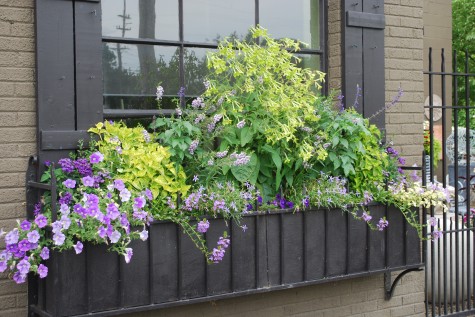 By August first, we were getting an 80 degree day once in a while. You can see the effect on the licorice and heliotrope; too little heat, too late. The flowering on the laurentia is slowing down, as I thought it would. Though the flowering is so- so, the plants are growing fine. The overall shape and the interaction of the group is the success of the box. Cool and dry made for unusually few bugs and no disease .
By August first, we were getting an 80 degree day once in a while. You can see the effect on the licorice and heliotrope; too little heat, too late. The flowering on the laurentia is slowing down, as I thought it would. Though the flowering is so- so, the plants are growing fine. The overall shape and the interaction of the group is the success of the box. Cool and dry made for unusually few bugs and no disease . By early September, my balanced box has gone too tall-bad maintenance on my part. Trimming plants back keeps them stocky, and encourages them to reflower. However, this height is a great look from the street; the flowers are visible over the boxwood.
By early September, my balanced box has gone too tall-bad maintenance on my part. Trimming plants back keeps them stocky, and encourages them to reflower. However, this height is a great look from the street; the flowers are visible over the boxwood.  As I predicted, the laurentia bloomed out, and needs replacing. By September 15, our weather is in transition. I expect night temperatures in the high forties this week yet. However, I am not willing to rip the boxes yet; I hold on to my summer season as long as I can. We are having our warmest daytime temperatures of the season. As there are plenty of plants that thrive in cool night temperatures, I will replace as needed.
As I predicted, the laurentia bloomed out, and needs replacing. By September 15, our weather is in transition. I expect night temperatures in the high forties this week yet. However, I am not willing to rip the boxes yet; I hold on to my summer season as long as I can. We are having our warmest daytime temperatures of the season. As there are plenty of plants that thrive in cool night temperatures, I will replace as needed. 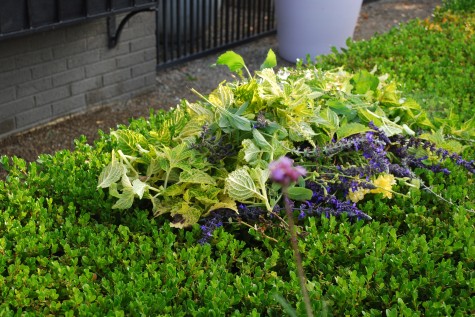 A good haircut and deadheading came first; late is better than never. As long as the warm weather holds, the coleus will respond quickly to the trim. There is no reason to give up what you have looked after all season. There is every good reason to keep what is good, and replace what isn’t.
A good haircut and deadheading came first; late is better than never. As long as the warm weather holds, the coleus will respond quickly to the trim. There is no reason to give up what you have looked after all season. There is every good reason to keep what is good, and replace what isn’t.
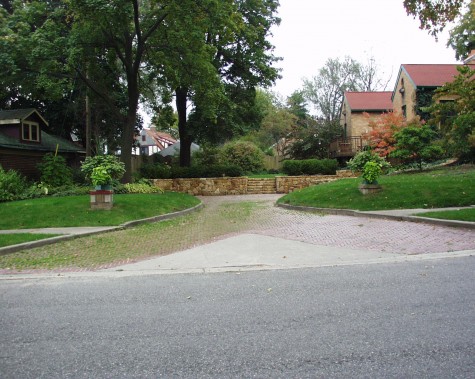 Just yesterday I was telling new clients for whom I had just finished a landscape master plan – pick one small part of your plan and install it. I told them if they got started, and kept at it, a very large piece of work would get done in no time. I did not realize how truly fast the years can go by, until I ran across these pictures of my own yard from 2000. After I moved in my house, I mulched some beds and grassed over others, until I could get to the work. I had just finished the stone wall and stairs; in 2000, my entire landscape effort was put to those walls. It would be years later before I would be able to do the limestone caps.
Just yesterday I was telling new clients for whom I had just finished a landscape master plan – pick one small part of your plan and install it. I told them if they got started, and kept at it, a very large piece of work would get done in no time. I did not realize how truly fast the years can go by, until I ran across these pictures of my own yard from 2000. After I moved in my house, I mulched some beds and grassed over others, until I could get to the work. I had just finished the stone wall and stairs; in 2000, my entire landscape effort was put to those walls. It would be years later before I would be able to do the limestone caps.
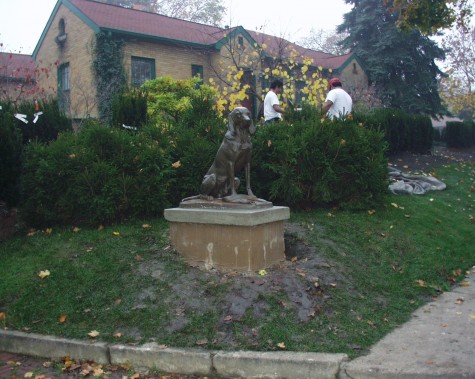 These antique French cast iron dogs guard the drive. The day of installation, my Hicks yews were 36″-42″ tall. Today they are almost nine feet tall. The dwarf picea mucrunulatum behind the dogs have more than doubled in height and width. In lieu of muddy lawn, I have sweet woodriff and hellebores. No doubt my gardening life has gotten better over the past decade.
These antique French cast iron dogs guard the drive. The day of installation, my Hicks yews were 36″-42″ tall. Today they are almost nine feet tall. The dwarf picea mucrunulatum behind the dogs have more than doubled in height and width. In lieu of muddy lawn, I have sweet woodriff and hellebores. No doubt my gardening life has gotten better over the past decade.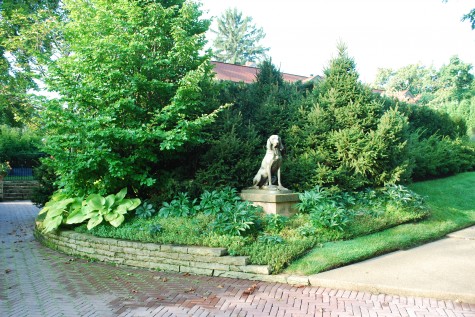 The parrotias, yews, picea, and magnolias screen my house from the street; I have a private home life in an urban neighborhood where the properties are small. The concrete pedestals built for the dogs have aged, and moss is growing on the walls.
The parrotias, yews, picea, and magnolias screen my house from the street; I have a private home life in an urban neighborhood where the properties are small. The concrete pedestals built for the dogs have aged, and moss is growing on the walls. 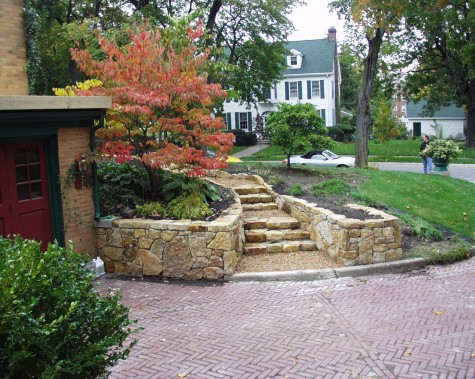 When I was at this stage of the landscape renovation, the thought of a decade of construction and growing never occurred to me. It just would take as long as it would take. The beginning of a project has its charms-the planning, the fussing, and the rethinking. The time has gone by incredibly fast; these low-tech time lapse photographs dramatically detail how much change there has been.
When I was at this stage of the landscape renovation, the thought of a decade of construction and growing never occurred to me. It just would take as long as it would take. The beginning of a project has its charms-the planning, the fussing, and the rethinking. The time has gone by incredibly fast; these low-tech time lapse photographs dramatically detail how much change there has been.  That stone staircase no longer looks so lonely and disassociated from the ground around it. The limestone caps got made for the walls. There is a woodland garden to go with the rustic staircase.
That stone staircase no longer looks so lonely and disassociated from the ground around it. The limestone caps got made for the walls. There is a woodland garden to go with the rustic staircase. I had forgotten the red and green trim that came with the house. The octagonal wood deck would get a stone skirt, and a narrow Romeo and Juliet balcony would be installed above the garage doors. The wood rails would be replaced with iron. My folly would be installed above the back porch.
I had forgotten the red and green trim that came with the house. The octagonal wood deck would get a stone skirt, and a narrow Romeo and Juliet balcony would be installed above the garage doors. The wood rails would be replaced with iron. My folly would be installed above the back porch. 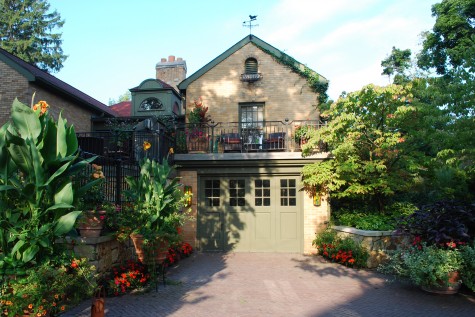
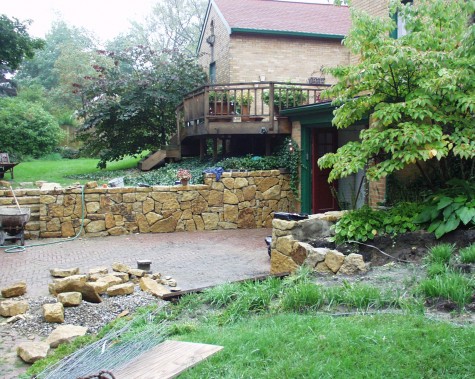 I am so glad to have these old pictures. I had forgotten how awful that deck and stairs looked. Without tearing the entire thing out and starting over, I do think the look of it is greatly improved. No landscape existed per se-I had a collection of plants. I am sure the previous owners liked each plant individually, but there was no thought put to their relationships to each other. My landscape is much more simple, and easy for me to maintain.
I am so glad to have these old pictures. I had forgotten how awful that deck and stairs looked. Without tearing the entire thing out and starting over, I do think the look of it is greatly improved. No landscape existed per se-I had a collection of plants. I am sure the previous owners liked each plant individually, but there was no thought put to their relationships to each other. My landscape is much more simple, and easy for me to maintain.